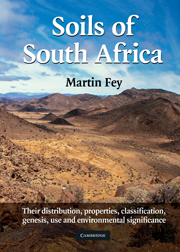Book contents
- Frontmatter
- Contents
- Preface and acknowledgements
- Chapter 1 Introduction to the soil groups and the naming of forms and families
- Chapter 2 The soil groups: distribution, properties, classification, genesis and use
- Chapter 3 Animals in soil environments
- Chapter 4 Profile descriptions and analytical data
- References
- Glossary
- Appendix: Criteria for generating distribution maps for soil groups
- Index
Appendix: Criteria for generating distribution maps for soil groups
Published online by Cambridge University Press: 05 June 2012
- Frontmatter
- Contents
- Preface and acknowledgements
- Chapter 1 Introduction to the soil groups and the naming of forms and families
- Chapter 2 The soil groups: distribution, properties, classification, genesis and use
- Chapter 3 Animals in soil environments
- Chapter 4 Profile descriptions and analytical data
- References
- Glossary
- Appendix: Criteria for generating distribution maps for soil groups
- Index
Summary
Digitised maps and data from the land type memoirs managed by the ARC Institute for Soil Climate and Water (ISCW) were interrogated using Arcview GIS software. The objective was to generate maps showing the distribution and abundance of each soil group. The soils information on the land type maps is based on the earlier binomial system of MacVicar et al. (1977) and it was necessary to make certain assumptions concerning the most appropriate group to which some soil series belong. This was especially the case for the humic soil group as well as oxidic soils with free carbonates which key out in the calcic group.
Selecting criteria for classifying soil series into groups and the mapping of abundance classes was done by M Van der Walt, T E Dohse and M V Fey. The following keywords (in quotation marks) formed the basis for defining each group. In most cases the keyword is a soil form abbreviation or a soil series code. Other criteria included pans ‘P’ in the gleyic group and dorbank as a depth limiting material in the silicic group.
ORGANIC SOILS
‘Ch’
HUMIC SOILS
‘Ia’ Or ‘Ma’ Or ‘Kp’ Or ‘Lu’ Or (to approximate thin humic families) ‘Hu16’ Or ‘Hu17’ Or ‘Hu18’ Or ‘Cv16’ Or ‘Cv17’ Or ‘Cv18’ Or ‘Cv26’ Or ‘Cv27’ Or ‘Cv28’ Or ‘Gf11’ Or ‘Gf12’ Or ‘Gf13’ Or ‘Gf21’ Or ‘Gf22’ Or ‘Gf23’
VERTIC SOILS
‘Rg’ Or ‘Ar’
- Type
- Chapter
- Information
- Soils of South Africa , pp. 282Publisher: Cambridge University PressPrint publication year: 2010



